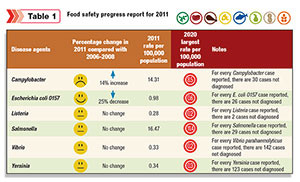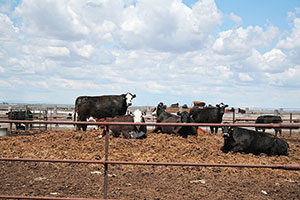If we multiply 67 pounds by 314 million people in the country, that means 21 billion pounds of ground beef is consumed per year.
Food-borne illnesses are a serious, justifiable concern to consumers.
Ground beef normally gets the most attention due to the increased publicity and volume of product recall.
The primary organism behind the recall is escherichia coli O157:H7 (E. coli O157:H7).
This organism can be deadly for some individuals and the meat processing industry has taken the threat seriously.
 Processors have developed numerous methods to reduce the incidence of E. coli O157:H7 in beef products and these methods have been successful (Table 1).
Processors have developed numerous methods to reduce the incidence of E. coli O157:H7 in beef products and these methods have been successful (Table 1).
Until recently, the focus has been to prevent contamination at the processor level.
Recently, there has been more attention to opportunities for ranchers to reduce the incidence of E. coli O157:H7 in the live animal pre-harvest.
Less E. coli O157:H7 in the live animal means less opportunity for product contamination.
Elimination of E. coli O157:H7 has been suggested by some as a possibility in animals. While this is a worthy goal, the organism and where it can live presents significant challenges that make eradication impossible.
The organism is present in a variety of animals, not just cattle, and has even been identified in wildlife.
The organism is also able to survive in environmental sources that provide a constant source of contamination.
A more achievable goal would be to reduce both magnitude and prevalence of fecal excretion by the animal.
This goal would be addressed primarily by management practices of the live animal pre-harvest.
Mud and water
E. coli O157:H7 can often be found on farms in manure, soil, water sources, bedding and certain areas in barns.
All of these sources can be opportunities of infection. If producers can eliminate or significantly reduce the presence of E. coli O157:H7 in these areas, then the likelihood of animal exposure is reduced.
This can most often be accomplished through on-farm cleanliness and sanitation procedures.
Bedding should be removed and replaced regularly. Attention to cleanliness in all areas of animal contact should be a priority.
The organism has been shown to be more prevalent in areas that are muddy and wet. The goal is to routinely clean areas where the organism has the opportunity to grow and become a source of infestation and limit containment of animals in wet, muddy corrals.
Water sources are one of the most common areas of contamination. Multiple research articles document a correlation between water contamination and the presence of the organism in animals that have been drinking from the water source.
Some of the same studies have examined a variety of water treatment options to eliminate the organism, with only limited success.
The most reasonable option is still to maintain cleanliness of water sources as much as possible.
This objective is much easier in confinement facilities where receptacles are accessible and can be cleaned regularly.
It is much more difficult in grazing operations where cattle may water from multiple sources and the actual cleaning of some is not possible.
Feed components
Feed and feed components have been suggested as a source of E. coli O157:H7 contamination and subsequent animal infestation.
Some feeds, even though not contaminated, act as modifiers of the digestive system, which results in increased microbial population.
The reasoning has been that some feeds will modify the gastrointestinal tract to favor the growth of E. coli O157:H7.
Feeding trials have realized controversial results. Some older studies suggested that the feeding of cottonseed and clover reduced fecal excretion of E. coli O157:H7.
Subsequent studies then reported that cottonseed in the diet actually increased shedding of the organism.
One controversial study that appeared in Science in 1998 compared high-concentrate diets to high-forage diets.
The authors claimed that switching from high-concentrate to high-forage shortly before slaughter would reduce the incidence of E. coli O157:H7 excretion in the feces.
This study is the most often quoted by those that promote a grass-fed beef product. Subsequent studies have not been able to produce repeatable results of that study.
Lactobacillus acidophilus culture has repeatedly been shown to be effective at reducing E. coli O157:H7 in feedlot cattle, in some cases as high as 50 percent.
This is a commercially available product and is currently fed in most large cattle feedlots in the U.S. Lactobacillus acidophilus is classified as a probiotic.
A probiotic is a product that contains defined microorganisms in sufficient numbers, which alter the microflora in a compartment of the host and exert beneficial health effects.
Probiotics are often used after a significant antimicrobial treatment regime to replace the beneficial microflora of the gastrointestinal system.
E. coli O157:H7 is a significant health concern for producers and consumers. Reduction in incidence must be a team effort throughout the production chain.
The producer can and should implement farm practices that reduce infestation opportunities for livestock.
The feedlot can reduce water and feed contamination and feed probiotics. The packing industry can continue to implement proven multiple hurdle methodologies to reduce final product contamination.
The production side of beef can and does utilize methods to reduce the incidence of E. coli O157:H7 in cattle.
However, it is impossible to remove the organism completely, which means there is still the opportunity for product contamination.
The consumer has the final responsibility, which is to handle and cook the product correctly to an internal temperature of at least 165ºF.
If all segments work together, the threat of E. coli O157:H7-contaminated meat will be minimal. ![]()
Kraig Peel is an assistant professor at Colorado State University.
References omitted due to space but are available upon request. Click here to email an editor.
PHOTO
Frequent replacement of bedding in the finishing stages promotes more cleanliness and can eliminate organisms increasing risks of E. coli. Photo by staff.









